Technical Data Sprockets for Large Size Conveyor Chains Smart Series Handling
Before Mounting and Removing
1. Notes
- ・There is a risk of extreme danger if, while replacing the sprocket or tooth inserts, gravitational balance is lost and leads to the shaft rotating or the sprocket/teeth falling off. Always securely support or anchor the sprocket and teeth before starting work. Also, ensure the work location is safe and that there is a sufficient number of people to assist.
- ・When removing ring and block type tooth insert sprockets, when using a torch to cut or otherwise remove stubborn bolts that will not budge due to the presence of conveyed material or sprocket corrosion, use a file or grinder to remove scratches, conveyed material, etc. from the mounting base seat. Place a patch (rod) with a diameter smaller than the bolt against the bolt and strike with a hammer to loosen the bolt.
- ・For especially heavy sprockets and tooth inserts, use the hanging hole and eyebolt taps provided. Firmly secure any slings or wires used.
- ・Thoroughly clean where the sprocket will be mounted on the shaft and the split pieces/mounting base of the sprocket. Use a file or grinder to remove any scratches, corrosion, conveyed material, etc. and give it a smooth finish.
2. Mounting Bolt
- ・When finally tightening the bolts and nuts, tighten little by little over several turns to ensure a uniform tightening. Finally, securely tighten the bolts and use a torque wrench to confirm tightness.
| Bolt size | M10 | M12 | M16 | M20 | M24 | M30 |
|---|---|---|---|---|---|---|
| Tightening torque [N・m] | 68 | 118 | 289 | 568 | 980 | 1960 |
Note) Use bolts and nuts having a strength grade of 12.9.
Steps for Mounting and Removing
1. Split Type
Mounting
- 1. Match the split sprocket to where it is to be mounted on the shaft.
When doing so, ensure the alignment marks on the teeth are aligned. - 2. When matching the split sprocket, there is no gap in the hub assembly surface but there is a gap in the tooth assembly surface. There will be no problems due to this when the chain engages the sprocket.
- 3. Use the accompanying spring washers and a torque wrench to ensure a secure, uniform tightening.
- 4. Ensure there is no misalignment of the split sprocket faces when mounting to the shaft.
Note) The split sprocket will not loosen in normal environments as long as the appropriate torque has been used.
In situations where heavy vibrations may cause the sprocket to fall and cause injury, use a thread locking fluid or take other measures to prevent loosening.
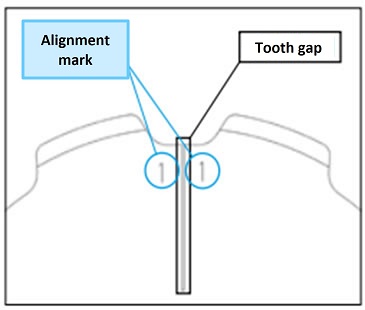
2. Ring Replaceable Tooth Type
Mounting
- 1. Ensure the alignment marks on the tooth inserts are aligned and temporarily tighten the bolts, spring washers, and nuts.
- 2. Adjust the inserts so that the mounting gap is uniform. The gap should be between 1–3 mm. There will be no problems due to this when the chain engages the sprocket.
- 3. Adjust so that the heights of the tooth insert bottoms are uniform with the heights of adjacent tooth inserts.
- 4. Spot weld all nuts in two places to prevent loosening. The sprocket is designed for use in harsh environments with vibration, impact, and corrosion. Securely prevent this loosening by spot welding all nuts.
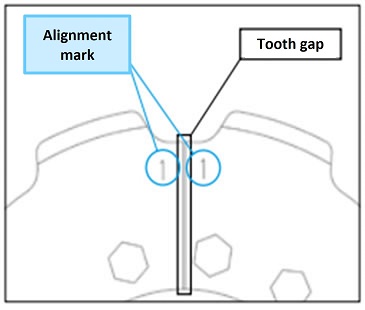
Removal
- 1. When removing tooth inserts, use a grinder to remove the spot welds.
- 2. Remove the bolts to remove the tooth inserts. When using a torch to cut or otherwise remove stubborn nuts that will not budge due to the presence of conveyed material or sprocket corrosion, use a file or grinder to remove scratches, conveyed material, etc. from the mounting base seat.
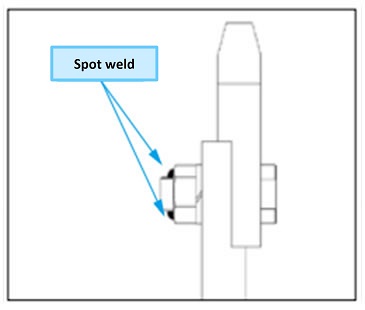
3. Block Replaceable Tooth Type
Mounting
- 1. Use a spatula to apply a coat of special adhesive to the entire surface where the tooth insert will be mounted.
- 2. When attaching the tooth insert to the mounting base, ensure that the bottom of the mounting base and the tooth insert touch.
- 3. Tighten the accompanying nuts and bolts once you are sure they are touching.
Note) When using block tooth insert sprockets with bucket elevators, attach bolts from the inner side of the conveyor to the outer side.
- 4. Use spot welding on all nuts to prevent loosening.
- 5. Leave for 24 hours to allow the adhesive to dry.
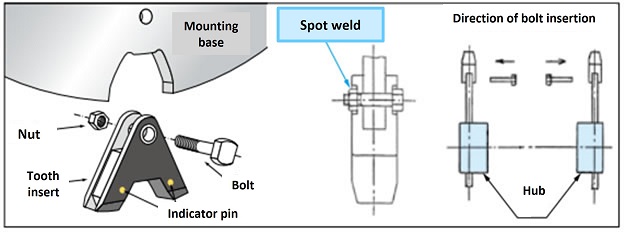
Removal
- 1. When removing tooth inserts, use a grinder to remove the spot welds.
- 2. Remove the bolts to remove the tooth inserts. When using a torch to cut or otherwise remove stubborn nuts that will not budge due to the presence of conveyed material or sprocket corrosion, use a file or grinder to remove scratches, conveyed material, etc. from the mounting base seat.
- 3. Remove the bolts to remove the tooth inserts. Be careful when doing so that the tooth insert does not suddenly come off and fall.
Indicator pins Inspection
Indicator Pins are a handy option that lets you know when to replace your sprockets with just a glance. Click here for details.
Follow the inspection steps below.
1. Inspection
- 1. Remove any material attached to the sprocket profile so that you can check the indicator pins.
- 2. The sprocket has reached its usage limit when wear reaches the indicator pins.
- ・There are two indicator pins (at roughly 0° and 180°) embedded into the teeth of each sprocket.
- ・The position of the indicator pins will vary by model. With finished bores, there will be one indicator pin located on the tooth nearest to the top of the keyway.
2. Notes
- ・Wear will rapidly accelerate if the sprocket continues to be used after wear has reached the indicator pins. This will also adversely impact the chain. We recommend immediate replacement.
- ・Replace your sprocket if wear exceeds 20% of tooth width t before reaching the indicator pins. Review your sprocket's alignment before wear exceeds 20%.
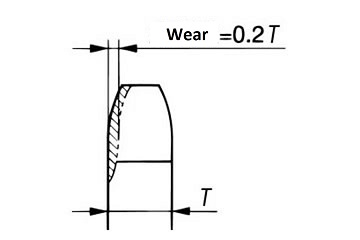
Tooth side surface wear

